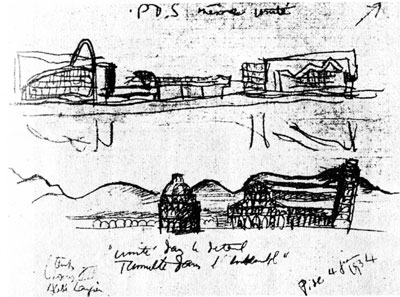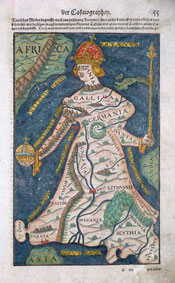You are in: Home page > Magazine Archive > European identity in architecture

Enrico Prandi
European identity in architecture

Le Corbusier, Comparison between the monumental elements of Piazza del Campo in Pisa and the competition project for the Palace of the Soviets in Moscow, 1934
Quizzing ourselves on the existence of a European identity in architecture[1] means reflecting on the possibility that European architecture is recognizable and identifiable as such within the heterogeneous international panorama. In other words, if there are, according to a logic of prevalence, certain characteristics that denote European architecture at different levels.
At the base of a personal response in the affirmative is the concept that the European city is detectable in its formal urban structure: from its foundation, very often surfacing from an orthogonal grid, to subsequent expansions, mainly implemented according to the logic of aggregation by parts.
Making architecture in a context as structurally defined as the European one, through a design idea that takes the architecture-city relationship to be fundamental, means working deductively on the concept of recognisability and hence identity, in the sense of its collective character.
But just what is Europe? The metaphor of the archipelago[2] identified by Massimo Cacciari deftly renders the idea of a fragmentation of the parts that make up the whole, a whole that is not even a homeland. For Cacciari “archipelago” is an irreducible plurality where individual elements coexist because they are unavoidably separated.
This "culture of differences" would also be, according to Jacques Derrida,[3] the very essence of Europe. A Europe that Paul Valery sees as a gigantic city with its museums, its gardens, its ateliers, its workshops and its drawing rooms. [4]
The exactitude of "Queen Europe" imagined and represented as a female human figure in Sebastian Münster’s Cosmographie, presents itself as a counterpoint to the real Europe, an entity with variable geometry progressively enlarging in its eastern borders.
In 2001, the finiteness of the conventional European flag (i.e. that featuring thirteen stars on a blue background) was countered by Rem Koolhaas with the idea of the bar code as a potentially infinite flexible system to be used as a wellspring of adjacent coloured bars borrowed from individual national flags.
At the basis of the consultation on behalf of the European Commission of a working group composed of intellectuals of different disciplinary and cultural extraction was the objective to discuss the need for and function of a European capital and a verification of just how the city of Brussels, unsurprisingly a major contender, could express such a role. [5]
The idea of a "soft" capital proposed by Umberto Eco in which the city becomes a management “server” for the European Union “network” in line with a computer science metaphor, opposes Rem Koolhaas’ idea of a "hard" capital that must vaunt its role as capital through symbolic new works of architecture.
One might wonder which kinds of architectural works Rem Koolhaas would have in mind to build the capital of all capitals for Europe: a tilted twisted skyscraper as in Beijing or a faceted prism as in Seattle? Works of architecture that are unable to recount the culture of the city they were born from but only their creator’s compulsive determination to be spectacular.
I therefore believe that there may be significance in the thought that Vittorio Gregotti reserved for the theme of a European identity in architecture:
"European architecture is however an architecture of distinction: distinction of the figures as the foundation of their necessary relationship, and analytical distinction of the parts that constitute the figures." [6]
But even more significant is the project that Gregotti presents as an example of this concept; Le Corbusier’s design for the Palace of the Soviets competition in Moscow in 1931.
"The sketch by Le Corbusier evokes, through comparison with Pisa’s Field [of Miracles], one of the urban compositional principles that traverses European architectural culture from the Acropolis up to modernity: the placing next to one another of differentiated volumes according to a strategy of positions that induce a special relationship between the separate parts."[7]
This, in my opinion, is the past, present and future way to design authentic European architecture.
[1] This essay harks back to the thread of the intervention at the homonymous round table held on May 6, 2011 at the Chamber of Commerce of Parma as part of the exhibition organised by the Festival of Architecture on the occasion of Parma’s Festa dell'Europa.
[2] The reference is to the book by Massimo Cacciari, L’Arcipelago, (Adelphi, Milan 1997) a second book on the theme of Europe after Geo-filosofia dell’Europa (Adelphi, Milan 1994).
[3] Jacques Derrida, L’altro capo, Jacques Derrida, Oggi l’Europa, Milan, Garzanti, 1991, p. 14.
[4] Paul Valery, conference held on 15 November 1922, at the University of Zurich. Currently in Paul Valéry, La crisi del pensiero e altri saggi quasi politici, Il Mulino, Bologna 1994.
[5] In May and September 2001, the President of the Commission, Romano Prodi, and the Belgian Prime Minister, Guy Verhofstadt, invited a group of intellectuals to discuss the need for and functions of a European capital and how Brussels could best express them. The Final Report can be found at: http://ec.europa.eu/dgs/policy_advisers/archives/publications/docs/brussels_capital.pdf
[6] Vittorio Gregotti, L’identità europea dell’architettura e la sua crisi, Einaudi, Turin 1999, p. 105.
[7] Idem, p. 105.

Sebastian Münster, Regina Europa, Cosmographia, 1588













